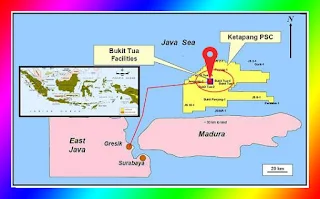The government is targeting the production of 1 million barrels of oil per day in 2025. To pursue this target, the government wants to increase the production of the Cepu Block.
Based on SKK Migas data, oil and gas lifting until 30 December 2019 reached 1.79 million barrels of oil equivalent per day (boepd). The realization is only equivalent to 88.6396 of the target of oil and gas lifting in the 2019 State Expenditure Budget (APBN) of 2 million boepd.
This year, the government is targeting oil lifting to reach 755,000 barrels per day (bopd) and 1.19 million boepd of natural gas. As a result, the total oil and gas lifting target throughout 2020 reached 1.95 million boepd. SKK Migas hopes that ExxonMobil Cepu Limited (EMCL) as an operator in the Cepu Block can immediately spur production. It's just that this effort is still hampered by the revision of the Environmental Impact Analysis (EIA) that has not yet been issued by the Bojonegoro Regency Government.
SKK Migas Deputy for Operations Julius Wiratno said, to date the process is still ongoing between the relevant ministries and the regional government.
"It's being worked on by the Ministry of Environment and Forestry (KLHK) which will invite the Amdal commission meeting," he said.
Dwi Soetjipto
Nevertheless, Julius was not sure when the meeting would take place. Not much different, the Head of SKK Migas Dwi Soetjipto stated until now the process of revision of the Cepu Block Environmental Impact Assessment is still ongoing.
"Yes, we are in the process, we have met several times," he said.
PT ExxonMobil Cepu Ltd (EMCL) successfully recorded an annual oil production of 218,000 bopd at the Banyu Urip field last year, this amount is equivalent to 29% of the total national oil production.
Louise McKenzie
ExxonMobil Cepu President Director Louise McKenzie said, Banyu Urip oil production last year had met the number of produced reserves in accordance with the plan of development (POD) of 357 million barrels. Louise McKenzie also admitted, the produced reserves from Banyu Urip have been renewed and could reach 940 million barrels.
ExxonMobil Cepu (EMCL) also hopes to increase and maintain oil production in the Banyu Urip Field in the range of 220,000 bopd in 2020. This is in view of ExxonMobil Cepu's status as one of the main pillars of oil production in Indonesia.
"We are trying to create prudent reservoir management to ensure production is maintained," McKenzie said.
the Jambaran Tiung Biru Project
The approval process for the Amdal revision was held in the Bojonegoro Regional Government. This is because the arrest of the Amdal revision approval was also accompanied by other requests by the Regional Government, including a gas request of 30 MMscfd from the Jambaran Tiung Biru Project.
IN INDONESIA
Revisi Amdal Blok Cepu Masih Menemui Jalan Buntu
Pemerintah menargetkan produksi 1 juta barel minyak per hari pada tahun 2025 mendatang. Untuk mengejar target tersebut, pemerintah ingin meningkatkan produksi Blok Cepu. Berdasarkan data SKK Migas, lifting migas hingga 30 Desember 2019 mencapai 1,79juta barel setara minyak per hari (boepd). Realisasi tersebut hanya setara 88,6396 dari target hfting migas dalam Anggaran Pendapatan Belanja Negara (APBN) 2019 yang sebesar 2 juta boepd.
Pada tahun ini, pemerintah menargetlkan lifting minyak mencapai 755.000 barel per hari (bopd) dan gas bumi 1,19juta boepd. Alhasil, total target lifting migas di sepanjang 2020 mencapai 1,95 juta boepd. SKK Migas berharap, ExxonMobil Cepu Limited (EMCL) sebagai operator di Blok Cepu bisa segera memacu produksi. Hanya saja upaya ini masih terganjal revisi Analisis Mengenai Dampak Lingkungan (Amdal) yang belum terbit dari Pemerintah Kabupaten Bojonegoro.
Deputi Operasi SKK Migas Julius Wiratno mengatakan, hingga saat ini proses tersebut masih berlangsung di antara kementerian terkait dan pemerintah daerah.
“Sedang diusahakan oleh Kementerian Lingkungan Hidup dan Kehutanan (KLHK) yang akan mengundang untuk rapat komisi Amdal," ujarnya.
Kendati demikian, Julius belum bisa memastikan kapan pertemuan itu akan terealisasi. Tidak jauh berbeda, Kepala SKK Migas Dwi Soetjipto menyatakan, hingga kini proses revisi Amdal Blok Cepu masih berlangsung.
"Ya, sedang berproses, kami sudah bertemu beberapa kali,” ujar dia.
PT ExxonMobil Cepu Ltd (EMCL) berhasil mencatatkan produksi minyak tahunan sebesar 218.000 bopd di Lapangan Banyu Urip pada tahun lalu jumlah ini setara dengan 29% dari total produksi minyak secara nasional.
Presiden Direktur ExxonMobil Cepu Louise McKenzie menyebutkan, produksi minyak Banyu Urip tahun lalu sudah memenuhi angka cadangan terprodulsi sesuai plan of development (POD) yakni 357 juta barel. Louise McKenzie pun mengaku, cadangan terproduksi dari Banyu Urip sudah diperbarui dan bisa mencapai 940 juta barel.
ExxonMobil Cepu (EMCL) pun berharap dapat meningkatkan sekaligus mempertahankan produksi minyak di Lapangan Banyu Urip di kisaran 220.000 bopd di tahun 2020. Ini mengingat status ExxonMobil Cepu sebagai salah satu tumpuan utama produksi minyak di Indonesia.
"Kami berusaha menciptakan manajemen reservoir yang prudent untuk memastikan produksi tetap terjaga," kata McKenzie.
Proses persetujuan revisi Amdal ini tertahan di Pemerintah Daerah Bojonegoro. Pasalnya, penahanan persetujuan revisi Amdal juga disertai permintaan lain oleh Pemerintah Daerah, termasuk permintaan gas sebesar 30 MMscfd dari Proyek Jambaran Tiung Biru.
Kontan, Page-14, Wednesday, Feb 12, 2020






























